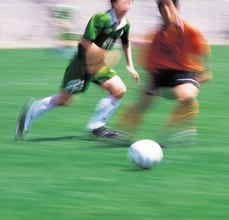Jan 26 2005
 By measuring how people respond when a stepping stone suddenly shifts its position mid-step, researchers at the Institute of Neurology in London have shown that a powerful visual process controls the stepping foot – a process similar to that used for manual reaching, in which the hand is rapidly and automatically driven by visual information.
By measuring how people respond when a stepping stone suddenly shifts its position mid-step, researchers at the Institute of Neurology in London have shown that a powerful visual process controls the stepping foot – a process similar to that used for manual reaching, in which the hand is rapidly and automatically driven by visual information.
This level of control may facilitate successful locomotion over unpredictable terrain; it must also be coordinated with balance, for example, when soccer players rapidly intercept a ball with their foot.
It is known that a strong visual process drives the hand as it reaches for an object. If the object moves as the hand homes in on it, the limb trajectory is automatically adjusted and the hand seems magnetically drawn towards the shifted object. These adjustments occur surprisingly quickly and are thought to involve fast visuo-motor pathways operating below the level of the cerebral cortex and conscious perception in the brain. The process ensures rapid target interception and may have evolved through its advantage for catching prey.
In the new work, Brian Day and Raymond Reynolds of University College London show that the foot is under the control of an equally fast visual process. Leg muscle activity is altered one tenth of a second after a stepping-stone movement, driving the foot towards the shifted target. This effect was unexpected because of the potential threat to balance. Balance is normally maintained during a step by a pre-step "ballistic throw" of the body that is tightly coupled to intended foot placement. Mid-step deviation of the foot would upset this coupling and could lead to a fall.
However, no subjects fell, suggesting visuo-motor and balance processes are fully integrated. This may be advantageous for bipedal locomotion over unpredictable terrain, which requires fast reactions from the leg based on immediate visual information, without loss of balance.